From public cloud and VDI, to rack mounted desktops, there are many ways to support flexible working through centralised workstations
If one thing has become clear in 2023, it’s that flexible working is here to stay. AEC firms that resorted to ‘sticking plaster’ hacks to get them through the pandemic, are now looking for more robust solutions to support staff working from home.
Centralising workstations and data is key but there are many ways to skin this particular cat — public cloud, private cloud, or on-premise Virtual Desktop Infrastructure (VDI). The humble desktop workstation is becoming as much at home in the data centre as it is on the desk.

In the UK, there are plenty of specialist firms that will happily replace your office workstation resource with one in a dedicated server room or the cloud. Many are laser-focused on the AEC sector, bringing expertise in BIM-centric workflows and data management as well as the remote workstations themselves.
Inevidesk goes hard on price with its custom ‘pods’. CreativeITC is addressing sustainability, Scan is applying its knowledge of desktops to the cloud, while IMSCAD has its eggs in many different remoting technology baskets.
Then, of course there’s the major public cloud service providers. Amazon Web Services (AWS), Google Cloud Platform (GCP) and Microsoft Azure give firms on-demand access to a wide a variety of GPU-accelerated virtual workstations anywhere in the world. And in true public cloud fashion, everything is elastic, so firms can upscale and downscale as needs change. This can be done directly through the cloud provider or via multi-cloud platforms like Frame or Workspot.
Performance can vary dramatically between VMs, which is something we explore in our in-depth technical report. If you don’t know your g4dn.xlarge from your NC16asT4v3 and everything in between, this is an essential read.
Public cloud has many benefits, particularly when it comes to global availability and IT management, but for performance alone, it’s impossible to compete with the desktop workstation.
With desktops, instead of giving each user a slice of a multi-core CPU or GPU, they get a dedicated resource, often with a CPU optimised for frequency rather than number of cores.
Firms including HP and Lenovo have cottoned on this and are now building rack mount and remote management capabilities directly into their personal workstations, blurring the boundaries between desktop and datacentre. You also get the simplicity of a 1:1 connection so you don’t need to get involved with the complexity and cost of virtualisation.
The Lenovo ThinkStation P7 and PX, for example, harness the power of Intel ‘Sapphire Rapids’ CPUs (read our analysis) and Nvidia RTX Ada Generation GPUs to handle some of the most demanding design, visualisation and simulation workflows. Meanwhile, with the HP Z2 Mini G9 you get incredible rack density in a workstation optimised for CAD, all managed through the HP Anyware remoting solution.
Finally, cloud doesn’t always have to play second fiddle to desktop in terms of performance. UK firm Armari, through its ‘Ripper Rentals’ cloud workstation service, has the most powerful Intel Xeon W-3400 and AMD Ryzen Threadripper Pro workstations we’ve ever used. With custom liquid cooling they push Intel’s and AMD’s flagship workstation processors to their absolute limits, delivering up to 19% more performance than standard aircooled desktops.
When it comes to workstations, there’s no one-size-fits-all approach. Some firms go all in on cloud or VDI, others use a variety of desktop, mobile and virtual, wherever they make sense. Centralised workstations can offer massive benefits, delivering performance wherever work may take you, but then you’re always reliant on good connectivity. And, as a recent rail journey from London to Sheffield reminded me, sometimes you can’t even get a simple web page to load.
This article is part of DEVELOP3D’s Workstation Special Report
Scroll down to read and subscribe here
Featuring
- Battle of the desktop workstation CPUs: Intel ‘Sapphire Rapids’ vs AMD Threadripper Pro
- Cloud workstations for CAD, BIM and viz – how the major public cloud providers stack up
- Lenovo ThinkStation P7 / PX desktop workstation reviews
- ‘Sapphire Rapids’ workstation round-up – Dell, HP, BOXX, Scan and Workstation Specialists
- Nvidia RTX 6000 Ada Generation professional GPU review
- Scan 3XS GWP-ME A1128T review
- AMD Radeon Pro W7800 / W7900 professional GPUs preview
- Reimagining the desktop workstation as a remote resource






